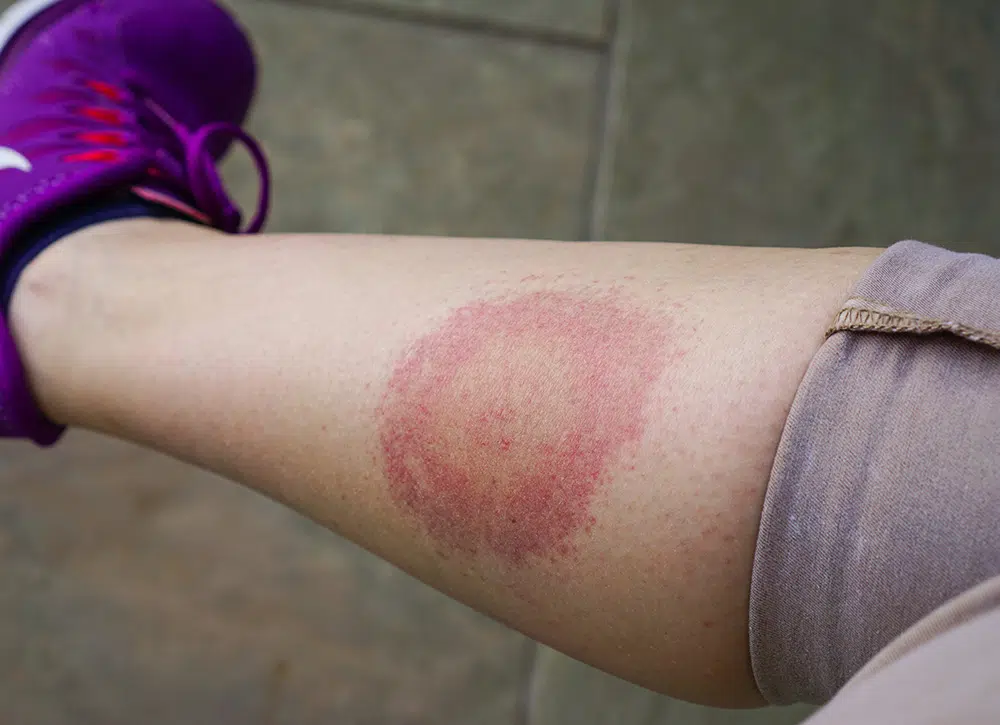
As you enjoy the great outdoors with friends and family this summer, it is essential to be mindful of ticks. The Northeast is home to a large concentration of deer ticks, which can carry and transmit the bacteria (Borrelia burgdorferi) that causes Lyme disease. This tick-borne disease can be serious and debilitating. It’s vital to understand when you should visit urgent care after a tick bite. ClearChoiceMD Urgent Care offers comprehensive treatment for tick bites, including Lyme disease testing.
What Does a Tick Bite Look Like?
Unless you notice a tick attached to your skin, you may not even know that you were bitten. You might see a small, itchy bump on your skin afterward, similar to a mosquito bite. However, this does not necessarily indicate that you have contracted Lyme disease.
A classic visual sign of early Lyme disease is the appearance of a reddened, circular rash around the bite. Often referred to as a bullseye rash, it may be warm to the touch but is not typically itchy or painful. Some people, however, contract Lyme disease without ever developing this rash.
When to Worry About a Tick Bite
Lyme disease is primarily carried by black-legged ticks, commonly known as deer ticks. Deer ticks have a very dark, almost black body and legs. Adult ticks have a lighter brown or reddish area on the rear of their body, which is largest on female ticks. It is important to be watchful for nymph deer ticks, which can be very small and can also transmit Lyme disease.
If a deer tick bites you but you don’t develop a rash or any symptoms, especially if the tick has only been attached for a short time, you likely do not need to seek medical attention right away. Remove the tick promptly, being sure that the head of the tick doesn’t remain embedded in your skin. A tick must typically be attached for 24 to 36 hours to transmit the bacteria that causes Lyme disease.
If you have been bitten by a tick or think you may have been, watch carefully for a rash or any symptoms. You should go to urgent care for a tick bite if you notice a rash or experience symptoms of Lyme disease, which can appear three to 30 days after being bitten by an infected tick.
Tick Bite Symptoms
In addition to a bullseye rash, other early symptoms of Lyme disease include:
- Fever.
- Fatigue.
- Headache.
- Joint stiffness.
- Aching or painful muscles.
- Swollen lymph nodes.
Later symptoms may include:
- Other rashes on your body.
- Neck stiffness or pain.
- Weakened facial muscles.
- Irregular heartbeats.
- Shortness of breath.
- Radiating pain from your back into your legs.
- Unusual sensations or pain in your feet or hands.
- Nerve pain.
Tick Bite Treatment in Urgent Care
When you visit ClearChoiceMD Urgent Care for tick bites, you can expect comprehensive diagnosis and treatment. Your provider will discuss your tick exposure and any tick bite symptoms that may indicate Lyme disease or other tick-borne diseases (such as Babesiosis or Anaplasmosis).
How Soon Do I Need Antibiotics After a Tick Bite?
If you are diagnosed with Lyme disease, it is essential to begin treatment with an appropriate antibiotic as soon as possible. Delaying treatment allows progression of Lyme disease, which can result in several complications, some of which can be long-lasting or permanent:
- Chronic arthritis.
- Body aches and pains.
- Memory problems.
- Frequent fatigue.
When you need urgent care for insect bites and stings, including tick bites, choose ClearChoiceMD. We offer rapid, excellent care at each of our convenient locations across New Hampshire, Maine, Massachusetts, and Vermont.


















